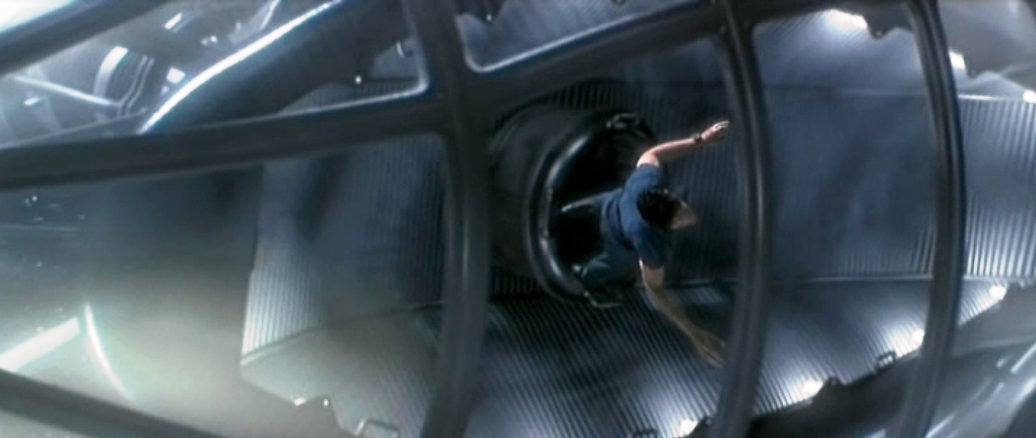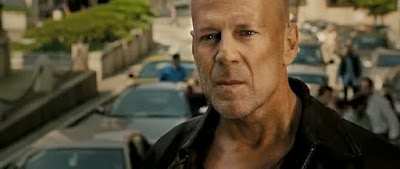John
McClane enters the 21st century – not to mention the post-9/11 age
-- in Live Free or Die Hard (2007), the first PG-13 entry in the
durable action franchise.
Although
it’s difficult to be particularly judgmental of the generally entertaining Live
Free or Die Hard (2007) -- especially given the quality of its
follow-up, A Good Day to Die Hard (2011) -- this movie also provides ample
evidence to suggest the franchise’s best days are behind it.
In
particular, Live Free or Die Hard features a bland, forgettable villain, played
by Timothy Olyphant, and regurgitates, almost precisely, the format of Die Hard
with a Vengeance by eschewing a single location story and partnering up
McClane with another bicker-some partner, in this case one played by Justin
Long. Where Samuel Jackson’s Zeus Carter battled McClane over issues of race, Long’s character offers a generational challenge to the put-upon cop.
Live
Free or Die Hard’s
greatest drawback, however, is that this third sequel to McTiernan’s 1988
classic transforms McClane into a veritable superman, one able to fly cars into
helicopters and surf a military jet in flight. The whole idea of the every-man
with a “die hard” personality is lost, to a great extent. And since Willis plays
McClane with greater restraint than ever before, we don’t even have his darting
eyes and furtive movements to suggest is he in constant jeopardy, or afraid for
his life.
Certainly,
there’s a great scene in Live Free or Die Hard wherein
McClane describes exactly what it costs him, personally and emotionally, to be
a hero, but that scene -- firmly planted in reality -- is but a passing blip in
a film that, intentionally or not, makes the case that McClane is as
indestructible as Arnie’s Terminator.
Len
Wiseman directed Live Free or Die Hard, and the movie was a huge success at the
box office. The film is no embarrassment (again, in light of A
Good Day to Die Hard…) so this second-guessing of ingredients is largely
academic. Still, this entry in the canon
accelerates Die Hard’s descent towards generic, mindless action franchise.
It may not be a bad movie overall, but it is another rung down the ladder
towards mediocrity.
The
fact that the movie’s PG-13 rating doesn’t even permit McClane to utter his
immortal catchphrase -- “yippee kay yay,
motherfucker” -- is an omen, perhaps, that business and demographic concerns
have finally eclipsed artistic ones in the Die Hard universe.
“You’re
a Timex watch in a digital age.”
After
arguing with his daughter, Lucy (Mary Elizabeth Winstead), divorced cop John McClane
(Willis) is tasked with bringing in a hacker, Matthew Farrell (Justin Long) who
may have knowledge of an escalating cyber-attack on financial markets and the
government of the United States.
At
the same time, however, assassins are sent to kill Matt, and John is once again
in the wrong place, at the wrong time, facing a terrible threat.
As
Matthew explains to John, a group of well-organized, well-funded hackers are
attempting a “fire sale” attack on the U.S.
When
John gets Matthew to Washington D.C., he learns that the culprit is the once well-respected
Thomas Gabriel (Timothy Olyphant), who pointed out to the government its lack
of defenses in the case of a cyber-attack.
Now
Gabriel is showcasing that lack of defense, but in reality, is planning a huge
cyber-robbery.
When
Lucy is kidnapped by Gabriel, John and Matthew must work together -- despite generational
differences – to short-circuit Gabriel’s escalating attack and save the
day.
They
will require the help of an expert hacker, a guy called Warlock (Kevin Smith).
“Another day in paradise.”
I’ve
written about this concept before, but in the first decade of the twenty-first
century -- just around the time of Live Free or Die Hard’s production,
actually -- TV and film switched places; suddenly switched paradigms.
Suddenly,
television was the venue for intelligent, niche programming that would never
have survived on a “big” network in earlier eras. Think Dexter (2006-2014), or Mad
Men (2006-2015). And movies, which had survived and thrived
through an independent film movement of great quality in the 1990s, began to become
horribly, catastrophically homogenized, so as to attract all possible
demographics and win the all-important opening weekend sweepstakes.
One
can argue why this switcheroo occurred and remains in place today, but Live
Free or Die Hard feels like it bears the weight of the switch.
Remember
how Die
Hard had all those weird-moments with pin-up girls, and Christmas party
revelers snorting coke and having sex?
There
are no moments like that in Live Free or
Die Hard.
Remember
how Zeus Carver and John McClane shared some really tough, really frank
conversations about race relations in Die Hard with a Vengeance?
There
is nothing so edgy or frank, or for that matter, real, in Live Free or Die Hard.
Remember
how John McClane’s catchphrase alone gets each Die Hard film a hard R
rating?
The
character’s very catchphrase is not uttered in the theatrical version of Live
Free or Die Hard.
It
all makes one wonder if Die Hard was sold in a “fire sale”
to Walt Disney Studios.
The
switch to a more generic, safer approach, ill-suits the Die Hard franchise,
because the films concern a stubborn man who is not easy to live with. McClane
is confrontational, and, well, edgy. John makes enemies wherever he goes
because he is “die hard.” He doesn’t tolerate fools, and he knows how to get
things done. If someone isn’t helping him with a problem, they’re part of the problem.
The first film made his world view abundantly clear, especially in terms of the
“Dwayne” character, a bureaucrat and fool.
So if you take away John’s ability to cuss, and you’re already downgrading
the individuality of the man, and his distinctive viewpoint.
But
much worse than censoring John’s ability to swear, is the film’s insistence on
censoring John’s ability to bleed, or break bones.
In
Live
Free or Die Hard, John McClane is thrown off a jet in mid-air and keeps
going. He doesn’t miss a beat.
John’s
timing and reflexes -- while traveling 55 miles an hour -- are so great that he
is able to “kill a helicopter” by launching a car at it.
These
are not the feats of a “die hard” police man; these are the feats of a
superhero.
Another
way to put it involves the concept of gravity. In the earlier Die
Hard movies, John accepts the limits of gravity, and works within those
limits to achieve his desired ends. He
sends C4 explosives strapped to a chair down an elevator shaft to blow up
terrorists with an RPG. Gravity is his
friend. The chair drops eighty or so
floors via the auspices of gravity. John delivers a bomb, in other words, with
gravity’s help.
The
set-pieces in Live Free or Die Hard, by contrast, are all about John defying
gravity. Jon surfs the back of a jet
fighter -- standing on two feet -- as it accelerates and spins high in the air.
When at last he is thrown off the jet,
he is flung a great distance, and his bones don’t shatter when he lands.
See
the difference? Here, he is not a man
working with gravity, he is a man somehow defying it…until he doesn’t. Look at
how he drives a several-ton truck up a steep incline, and it doesn’t tumble
down, towards the Earth. At least not immediately.
Here,
it is clear, we have moved into the terrain of outright fantasy. Die Hard becomes a stunt-filled
comic book instead of a film series about a guy who is so stubborn, so thorny
that he will just not give up.
It’s
a huge shift in the paradigm, and one that doesn’t fit well with series
history.
Some
of the outrageous stunts here would be more forgivable, perhaps, if we felt
more in touch with the characters.
Timothy
Olyphant’s character, Thomas Gabriel, is the Marco Rubio of Die
Hard villains. He’s young, he’s attractive, and he’s hip, but…on close
analysis, he’s nothing more than acceptable.
Like
the villains in all the Die Hard movies, Gabriel is supposed
to be a cunning and brilliant thief, who cloaks his venal love of money behind
some act of apparent terrorism, in this case one that reveals to the U.S.
government how vulnerable it is to cyber-attack.
But
ask yourself a question: do you ever once believe that Olyphant’s Gabriel is a
thief? Pulling a con? Does he ever get a
truly memorable scene, or even a memorable line of dialogue?
Mostly,
he’s just a handsome bad guy who fits the template of action movie
villain. Now, this isn’t an attack on
Olyphant, who is a great actor and has delivered remarkable performances in TV
series such as Deadwood (2004-2006) and Justified (2010 – 2015). Even
Olyphant has reported that the character of Gabriel is undeveloped.
Gabriel
looks good, provides some generic menace, but never shows off any real
humanity. The best two villains in the Die Hard series -- played by Alan
Rickman and Jeremy Irons, respectively -- ably convey humanity. We get the sense that they are particularly clever
robbers, ones engineering the greatest cons (and robberies) of all time. There’s no sense of joy or accomplishment
from Gabriel. He’s an off-the-shelf, generic villain to go with the
off-the-shelf, generic action scenes.
I
appreciate aspects of the film. I appreciate that John is now world weary;
beaten down by life. He sees very clearly that fighting bad guys has not made
him happy, or held his family together. He has many regrets. This is all conveyed in a powerful scene, and
the moment demonstrates why Willis is so great for this role. He boasts great range as an actor.
But
that’s the thing. The screenplay must
make use of that range. Not just here or there.
All the time.
We
should be encountering a John McClane who is in danger, on the edge,
half-crazy, running on adrenaline. The
movie rarely uses him in that way. Like
a real person. Like a person we will
wish we could be.
Except
for a flash of humanity here or there, McClane might as well be played by
Schwarzenegger this time out.
So
no, this movie doesn’t “die hard.”
But it doesn’t exactly “live free”
either.
It
lives, instead according to the sanctified rules of homogenized movie-making in
the 21st century. The key rule
of that style of movie-making is: be as broad-based in your appeal as possible,
no matter the subject matter of your film.
It’s
all… “Yippy-kay-yay…you (gender neutral, PG
rated put-down).”
And
that’s a disappointment.






























































